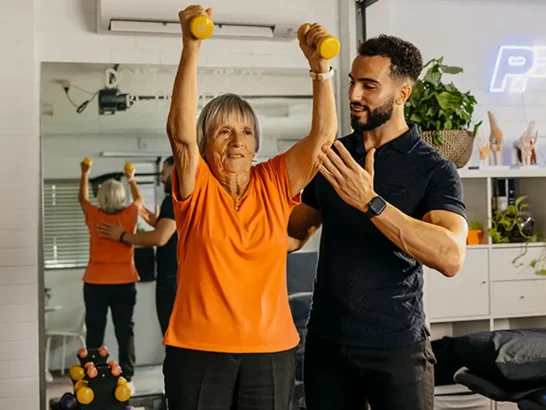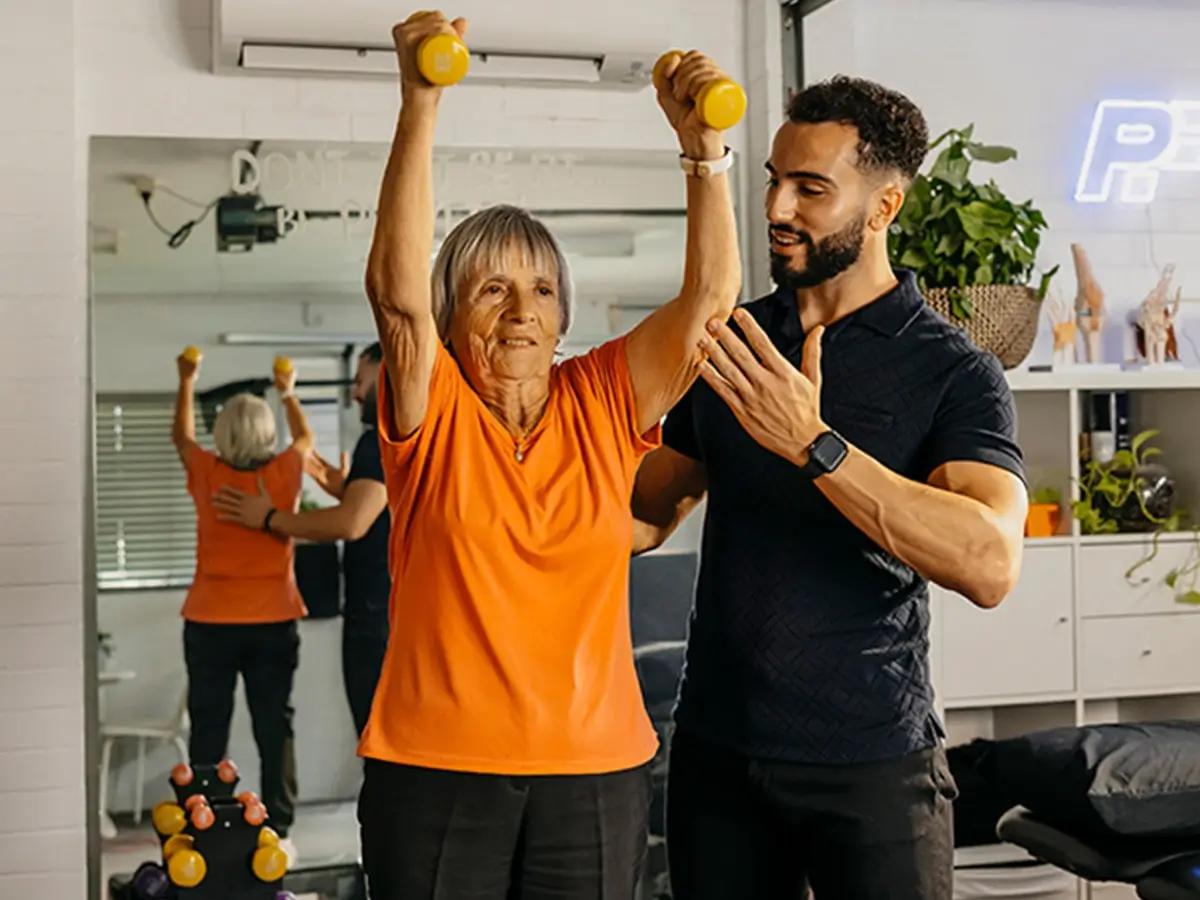Having a stroke may impact how you sit, move, balance and stand, making it difficult to perform the everyday activities you want to do.
If you’ve had a stroke, exercising can help improve your general health and, importantly, reduce your risk of having another one. Exercise also has benefits for your cognitive function and emotional wellbeing.
Despite these benefits, it can be hard to get enough exercise when recovering from a stroke because of restricted mobility, fatigue and a lack of guidance. A qualified physiotherapist can help assess the impact of a stroke, and work with you on a rehabilitation program so you can reach your goals.
To help you in your recovery, independent support workers on Mable include qualified allied health professionals, and disability and care support workers to help you implement and maintain exercise routines.
Why exercise is important for stroke recovery
After a stroke, exercise can help to bring back movement, increase your fitness levels and allow you to undertake daily tasks and enjoy the activities you love.
Common physical effects of stroke include muscle weakness, a lack of balance, cognitive issues and fatigue. Exercise can make a difference, with the results continuing long after the early stages of stroke recovery.
Physical activity can also help manage health conditions and reduce risk factors for a further stroke, such as:
- Blood pressure
- Diabetes
- Obesity
If you or someone you know who has experienced stroke, independent support workers on Mable can help in recovery and rehabilitation. Through the NDIS or aged care support, you may be eligible to receive support from specialised qualified allied health support workers.
How a stroke can affect mobility, movement and mood
The physical benefits of exercise for stroke survivors
After a stroke, you may suffer from muscle weakness and/or rigidity, reduced co-ordination and decreased sensation in affected body parts.
Your physiotherapist will work with you to develop an exercise and rehabilitation program that is best suited to your body, needs and goals.
There are many benefits of exercise for stroke survivors. These include:
- Improved muscle strength and coordination
- Better balance and stability
- Increased range of motion and flexibility
- Enhanced cardiovascular health
- Pain management and circulation improvement.
The cognitive and emotional benefits of post stroke exercise
Getting regular exercise not only improves your movement and strength, but it can also help to improve brain health.
Improved brain function and memory
After a stroke, some people may have trouble with clear thinking, reasoning, awareness, and memory. Blood flow to the brain is cut off during a stroke, and brain cells can die or suffer damage. This can change how a person communicates, moves, thinks, and feels.
Structured exercises recommended by a qualified allied health professional may help to improve these cognitive abilities.
Enhanced mood and emotional wellbeing
After a stroke, you may experience feelings of loss, frustration and worry. It may also be hard to stay motivated with your recovery. Exercising helps to improve your mental health and wellbeing through the release of endorphins and serotonin that work to boost your mood.
Greater sense of independence and confidence
Self-efficacy is a measure of confidence and is associated with better mobility, balance, and physical function after stroke. A lack of confidence can sometimes become a barrier when you’re recovering from a stroke.
Regaining mobility through exercise may increase your confidence in your own abilities to perform tasks like getting dressed, cleaning, and going to the shops.
A physiotherapist or occupational therapist can outline a plan for you to follow, while a support worker can assist you in achieving your exercise milestones by keeping you motivated and supported.
Better sleep quality and reduced fatigue
Post-stroke fatigue is a common challenge when recovering from a stroke, but physical activity can help regulate your energy levels.
Regular exercise can improve sleep patterns and can help you to feel more awake during the day.
How exercise can help to prevent a second stroke
Getting regular physical activity also plays a key role in reducing risk factors that can lead to another stroke.
Lowering high blood pressure
High blood pressure is one of the leading causes of stroke but in good news, getting regular exercise can help combat it by regulating blood pressure and improving overall circulation.
Preventing obesity
Being clinically overweight or obese is a high risk factor for stroke. Exercising regularly and eating a balanced diet can help to manage weight and blood sugar levels.
Best at-home exercises for stroke patients
Many stroke survivors participate in a variety of short-term fitness training regimens, either during usual stroke care or after hospital discharge.
An allied health professional like a physiotherapist may provide you with a plan that has a mix of cardio and resistance training.
Strength and mobility exercises
Strength and mobility training can be crucial for stroke survivors seeking to regain muscle function and control, improving walking ability and overall movement.
Qualified physiotherapists can help you to strengthen muscles, improve mobility, and support rehabilitation, while other types of support workers can assist you with safe movement and to stick to your routine.
Balance and coordination exercises
Balance and coordination exercises are also helpful ways a physiotherapist can help stroke survivors to reduce their fall risks and improve mobility.
Balance and coordination exercises may include:
- Seated and supported balance exercises
- Standing balance and coordination drills.
Cardiovascular and endurance exercises
Cardiovascular fitness is another tool that stroke survivors may choose to explore to potentially help:
- Improve heart and lung function
- Reduce fatigue and increase stamina
- Lower the risk of secondary strokes.
Your physiotherapist may develop a plan involving some cardiovascular exercises, like walking and some light resistance training.
A support worker may be able to accompany you on a walk, in line with any recommendations that your physiotherapist has recommended to you.
Other engaging physical activities for stroke patients
Low-impact outdoor activities
Exercising doesn’t have to be done alone. If your physiotherapist recommends it, some gentle types of physical activity can include walking in a park or swimming.
Independent support workers on Mable can help you take part in exercises, by driving you to the local pool, being a support on a walk, and encouraging you through your chosen activity.
Group-based fitness and therapy classes
Exercising with others might boost your mood and provide you with important social connections.
A support worker can accompany you to these classes and ensure they can assist you to follow the instructions given to you by the professional.
Considerations when engaging in physical activities after a stroke
Each stroke survivor has unique needs, so it’s important to talk to your physiotherapist, doctor or occupational therapist before starting anything new.
Qualified allied health workers can help guide you on what exercises are best for your recovery. They may recommend that you start with:
- Gentle movements like walking or stretching before progressing to more structured exercise
- Focusing on balance, coordination, and strength-building to aid rehabilitation.
When engaging in physical activities following a stroke, it is important to engage in physical activities safely and carefully. Speak to a healthcare professional for advice on how to minimise safety risks while still focusing on your mobility as you recover from a stroke.
Accessing qualified exercise and rehabilitation support for stroke on Mable
Mable can help you connect with different types of support to help you in your recovery after a stroke.
Allied health therapists include physiotherapists, occupational therapists, speech pathologists and psychologists.
You can also find other support services on Mable to can help with daily personal activities and travel, therapeutic support, help with household tasks, and aids and equipment.
Get started on Mable to begin building your support team.
FAQs
When is it safe to start exercising after a stroke?
A stroke impacts people in different ways. Your medical team will let you know when you can exercise safely, and you can work with a physiotherapist on a rehabilitation plan so you can build up your strength and mobility over a period of time.
How does regular exercise reduce stroke risk?
Exercising consistently after a stroke can help to prevent stroke risk factors such as high blood pressure, high cholesterol, and diabetes, and reduce the likelihood of having another stroke, according to the Stroke Foundation.
How can a stroke survivor start to engage in exercise?
Your physiotherapist will be able to develop a rehabilitation plan with you that meets your needs and helps you to reach your goals.
The information provided in this article is general information only and based on current information at the date of publication. In addition to considering the information shared in this article, Mable encourages you to conduct your own research and seek independent medical advice about managing life after a stroke in your particular set of circumstances. If you wish to use your NDIS funding on any of the services outlined above, Mable recommends that you check your NDIS Care Plan or speak with your Plan Manager to ensure that allied health services are coverable.

